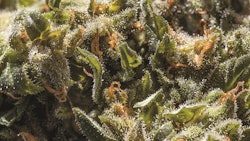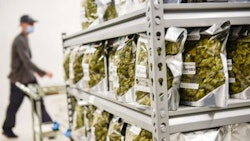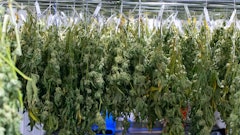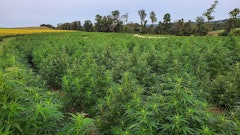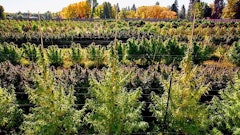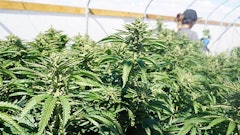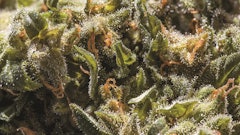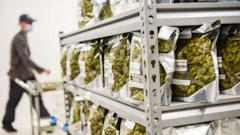
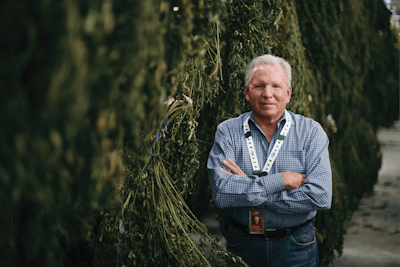
Bob DeGabrielle
All photos by Malissa Ahlin
In business, everyone answers to someone: Employees answer to managers; managers answer to executives; executives answer to board members; and board members (or at least their investments) answer to consumers. Farmers, however, also must answer to an unpredictable force: Mother Nature.
That is the reality that Avondale, Colo.-based Los Sueños Farms (“los sueños” is Spanish for “dreams”) must contend with as the operator of one of the U.S.’s largest outdoor cannabis farms. Employee time off, workload organization and holidays are all scheduled around the demands and opportunities the environment presents at the 36-acre farm.
For Bob DeGabrielle, owner and founder of Los Sueños Farms, the decision to operate outdoors, despite its challenges and inflexibility, was a fairly simple one. After assisting an ultimately unsuccessful attempt to legalize medical cannabis in Florida in 2010, DeGabrielle moved to Colorado to learn about the upstart industry in the Rocky Mountain State. “I felt it was much like Napa Valley in that you got there early, before everything else was developed, and you got a knowledge of what was going on,” he tells Cannabis Business Times. His background in financing and real estate allowed him to connect with many cannabis industry hopefuls, whom he would help by securing funds for a start-up or help build a dispensary storefront.
That experience taught him many lessons, but the most important one, DeGabrielle says, was that cannabis, essentially, “felt like any agriculture product: it’s eventually all going to depend on supply and demand.” When two brothers who had won an outdoor cultivation license in Pueblo approached him with a plan for a partnership, he jumped on the opportunity, figuring that “growing outside was a lot less expensive than growing inside, and Pueblo was a lot less expensive than Denver.”
Six years and tens of thousands of harvested plants later, he hasn’t regretted his decision as, by his count, he has built a consistently profitable company that generates eight-figures in annual revenue, has shelf-space in 180 dispensaries and works with 40 extraction and manufacturing partners.
Precision Farming
With the idea that cannabis cultivation simply was a more regulated form of standard agriculture, DeGabrielle started building his team in 2014. One of his first hires was Ryan Kinnison, Los Sueños’ farm manager. When DeGabrielle approached Kinnison about working at the cannabis farm after Kinnison had wrapped up a talk at a local meeting on greenhouse operations and water efficiency (an important topic in Colorado), Kinnison was upfront: He had no experience cultivating cannabis, let alone at scale. As the farm manager remembers, DeGabrielle said he wasn’t looking for someone who would pick out the dankest strains, but rather someone who could “go out and plant 30,000 plants in a matter of two weeks.”
Kinnison’s background is in traditional agriculture—organic food production for grocery chains like Whole Foods and Kroger, to be precise. He understood that it takes a structured plan to plant 30,000 (40,000 today) clones in a short amount of time.
To have a healthy October harvest, Kinnison and his team start planting the field in mid-May. The plants, which have been placed in 4-inch pots after the cloning stage for two weeks to grow their root systems, need to be about 6 inches tall and have root balls measuring 4 inches on all sides to have the best survival rate, Kinnison notes. Any smaller and those clones will wither in a spring cold snap, while larger plants have a more difficult time hardening off. That size plant also works great with transplanting equipment, the farm manager says.
Once plants are in the ground, Kinnison and his team rely heavily on precision farming principles to manage and maintain their crop. Precision farming, or precision agriculture, is a method by which farmers leverage new technologies and precise monitoring to maximize resource efficiency and plant productivity. “This is a high-value crop,” Kinnison says. “We want every piece of that land to be as optimized as possible.”
A big part of that is soil sampling and testing. Twice per year, Los Sueños Farms sends out one sample for every acre of canopy it grows. The post-harvest soil samples show the company exactly where in the field which nutrients were used and by which cultivars. A second sample is taken mid-season, when “plants are heavily feeding and growing actively,” Kinnison says, allowing the cultivation team to “start addressing any deficiencies that may be starting to show up.” Tissue samples are also sent in for analysis.
Knowing which nutrients the soil contains and what the plant has taken up allows Los Sueños to be efficient with its nutrient applications, feeding the soil only the elements it needs, when and where it needs them. Having both soil and tissue samples analyzed also tells the team whether the problem is with the plant or the soil. “Say we’re low on potassium,” Kinnison poses. “Well, is the potassium in the soil? If the answer is no, then we need to get some potassium in the soil. If the answer is yes, then … why is the plant not uptaking the potassium? Is it bound up in the soil because of a pH issue? Is it not available?”
Cultivar rotation, cover crops (ryegrass is planted after every harvest) and intercropping also play a role in keeping the soil healthy. By rotating cultivar locations and utilizing cover crops during the winter, Los Sueños ensures that not one part of the field gets overworked. The company intercrops by planting one row of non-cannabis crops amid the cannabis canopy and moving that row over every year.
“During the summer months, we will plant a summer cover crop and that will have a bunch of legumes in it,” Kinnison describes. “So they’re nitrogen-fixing type plants. Next year, I will move that row over and plant where the row, where the alleyway was this year. … So the bed shifts over, and we’re not planting the crop exactly in the same spot [as] in the previous year.”
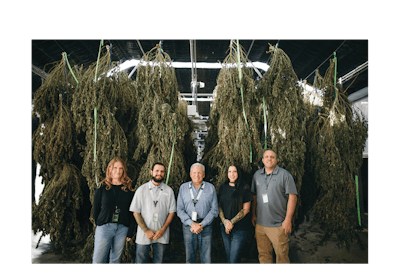
Ag-Tech Combined With Cannabis
Automated systems also help with reducing labor and maximizing productivity. For example, a drone helps Kinnison track plant health. The drone is equipped with different types of camera lenses, allowing the cultivation team to look at heat maps, chlorophyll development maps (chlorophyll levels can be a good measure to gauge whether a plant is overwatered or lacks fertilizer, Kinnison explains), and stress maps. “The stress map is really good at picking up on disease and insect pressures that we’re not able to see with the naked eye quite yet,” Kinnison says.
Los Sueños Farms also is equipped with a GPS tractor—a self-steering machine common in traditional large-scale agriculture, which can be programmed to move through a field within a one-inch margin of error. This is helpful in two main ways, Kinnison explains. First, not having to worry about the direction the tractor is moving allows the driver to focus on the task happening behind, whether that’s tilling, laying down plastic covers, or installing the more than 15 miles of drip irrigation lines needed to feed the company’s crop. “You’re able to focus on the task that’s being done because the tractor is taking care of the driving part for you,” Kinnison says.
Second, the tractor can be programmed to make rows as wide as a cultivar needs. As Kinnison puts it, corn farmers typically cultivate a monocrop, meaning they will grow one variety in their field and can evenly space out each stalk. Cannabis growers often grow multiple varieties in the same field, each with their own physiologies. Some varieties that grow larger might need 8 feet of space between each row, while more compact varieties might only need 3 feet. Measuring out that space is automated, thanks to the GPS tractor.
Another piece of ag-tech used at Los Sueños is an electrostatic sprayer (ESS), a tool that helps with pesticide application. An ESS resembles a standard sprayer, except that it adds an electrical charge to the liquid solution as it leaves the nozzle. “Now we have this particle of water flying through the air, and it’s got a positive charge. It’s looking for anything that’s negatively charged,” Kinnison describes. “When it comes over to the plant … it actually … attaches to the plant target.” The positive static charge will allow the droplets to attach to the underside of the leaf surface and into the nooks and crannies of bud structures, where most pests live and thrive, giving the crop a deeper and more complete coating.
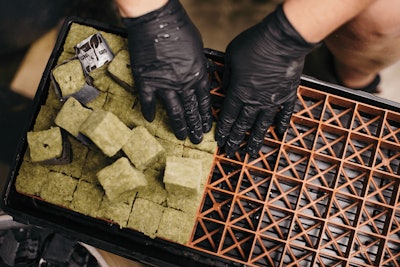
The Post-Harvest Process
Once plants are harvested, Chris Johnson, Los Sueños’ processing manager, takes over. He is another of DeGabrielle’s early hires, working his way up from order fulfillment to overseeing post-harvest processing, quality control (QC), packaging and sales. He leads a team of 92 workers who put in roughly 50,000 man-hours of labor in the three months following harvest.
Harvesting 40,000 plants took the Los Sueños team 23 days this year, Johnson says. Which plants get taken down first is mostly dictated by cultivar types: Faster finishing plants get harvested earlier in the process, while those needing an extra week or two are scheduled for harvesting later. This staggered approach also helps Los Sueños manage its drying space, which, relative to the current scale of the operations, is a bit small.
“One of the challenges that we have here is our drying capacity,” Johnson explains. Each licensed site (the company has four cultivation licenses it operates on the property) includes a greenhouse and hoophouse that are used as drying stations. Given how much biomass needs to be dried, Los Sueños dries its crop in two batches. “We’ll dry the plants out for seven to 10 days, and now we’ve got to take these plants down, process them, get them into a barrel, and then I can go ahead and start filling [the greenhouses and hoophouses] up with fresh plants again.”
Exhaust fans, dehumidifiers and humidifiers allow Johnson to control the drying environment. Each plant weighs 30 to 60 pounds and must be hang-dried. Team members hang plants by hand, Johnson explains. Larger plants are cut into sections to avoid having staff hoist heavy plants above their heads. “If we’re harvesting 3,000 plants a day, that person’s touching at least 1,500 plants a day, at 30 pounds [per plant], it’s pretty labor intensive,” Johnson says.
Just as planting the crop has a deadline, harvesting the crop is a yearly race against the clock and elements. Not only does Los Sueños have orders to fulfill, but the longer harvest takes, the higher the chance of encountering early snowstorms or freezes.
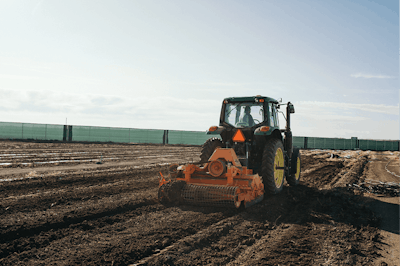
This year’s harvest went off without much ado, according to Johnson. Last year, however, an early freeze that lasted three days “ruined 50% of our crop,” he says. Frost blankets can offer some protection for outdoor cultivators, but the farm’s location in a wide-open plain makes those less effective. “We’ve tried [frost blankets], but we’ve come in the next morning and it was just blown off the plants,” Johnson describes. Thankfully, Los Sueños was able to use most of the frostbitten flower for extraction, avoiding a complete loss on that portion of the crop.
Extracts are a big revenue-driver for Los Sueños: The company sells roughly 80% of its crop to various extraction partners for refining, saving the balance for its flower line, which it sells as a lower-shelf product to dispensaries, according to DeGabrielle.
After drying, flowers are removed from the stalks using a stripping machine before moving to a conveyor belt where they undergo quality control. Buds are then sorted by size by another machine before being trimmed on a customized trimming machine that is able to process up to 800 pounds of flower per hour, Johnson says.
Product sent for extraction receives a similar treatment, except it is milled and blended to facilitate the extraction process for the company’s partners.
The next step in the post-harvest process the company is looking to automate is packaging, labeling and sealing. Currently, Los Sueños’ flower products are packaged by hand. While the packaging team is able to bag a half-ton per day, efficiencies could be improved, Johnson says. “You’ve got five people sitting there filling bags pretty much all day, and then two people weighing these bags and making sure everything’s correct.”
Supply Chain Management
The way Los Sueños splits its crop between extraction and flower is not a haphazard guess: DeGabrielle studies the market and uses wholesale pricing reports to track demand trends. “We use metrics that we obtain through different sources, but in particular [cannabis market research firm BDSA], to look at each one of the [product] categories, understand the categories, understand the customer, understand the pricing, the market demand and the supply,” he says. “We understand our whole supply chain.”
The COVID-19 pandemic certainly affected the supply chain, with consumers shifting purchasing habits and Colorado tourism, which saw approximately 85 million visitors in 2018, taking a nosedive under stay-at-home orders. But Los Sueños was still able to grow its revenues substantially—DeGabrielle projects the company will have grown its sales by 65% compared to 2019. He also says the team is on pace to sell its entire 2020 harvest, a feat it has accomplished every year since the company’s inception in 2014.
Working with some of the larger extraction labs in the state certainly helps, he explains. “In cannabis, like most industries, 80% of the business … ends up being done by 20% of the market,” he says. “We understand the importance of these [extractors] having reliable, dependable, and consistent supply chains,” he says. This focus on market needs dictates what is grown in the fields, and how it is grown.
Apart from being able to order large volumes, Los Sueños looks for partners who have interesting product lines that fill a market need. “We like to identify up-and-comers—people that have a process or a product line that we feel the consumers are going to be interested in,” says Melanie Fire, the company’s chief operating officer. The company can extend payment terms to these upstart companies to help that company “get that product off the ground faster,” she adds.
Despite good partner relationships, outdoor products fetch a lower price than greenhouse- or indoor-grown flower. To help keep costs in line, Fire makes sure employees are cross-trained in different tasks to ensure the team (and payroll) is as lean as possible. “I would rather pay less people more, than more people less,” Fire says.
Employees who show initiative and take on tasks without prompting are identified and promoted, DeGabrielle says. This keeps turnover low and staff motivated, important factors in a marketplace that lacks skilled labor, he says.
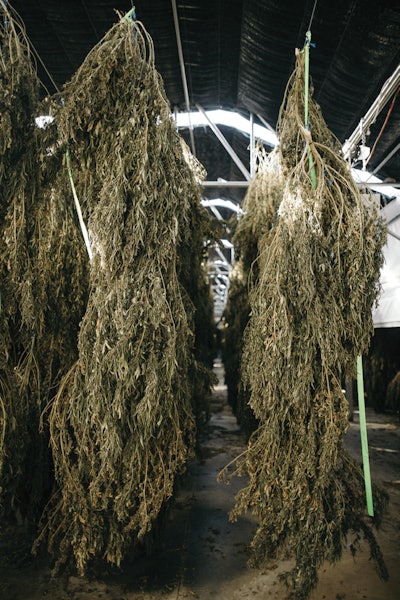
Next Harvests
Looking ahead, DeGabrielle hopes to continue to expand the company, as he has done every year. Earlier in 2020, he explored an acquisition deal with Schwazze (formerly Medicine Man) that would have created one of the state’s largest vertically integrated companies, with subsidiaries spanning the cultivation, manufacturing and retail markets. That deal fell through in July (shortly after DeGabrielle left the position he had taken as COO of the upstart conglomerate in June), but he says he is still exploring other opportunities in which all parties would be contributing to the company’s performance—no silent partners nor people looking for cash buyouts, he says. Teaming up with other companies to fortify one another’s supply chains and save on shared costs is one of the few ways he believes Los Sueños can survive the massive publicly traded companies (such as Altria and Constellation Brands) that will rush into the U.S. cannabis industry once federal legalization happens.
Additionally, DeGabrielle is identifying nearby properties that could accommodate the company’s expansion. Those properties should have more structures for drying each harvest, Johnson says, which would help reduce drying times.
Kinnison is most excited to work on the company’s genetics and the agronomic progress that can be made there. “If we plant a better plant to begin with, it’s going to make the company hopefully … more money and … better product,” he says, referring to cultivating with pest, disease and drought tolerance in mind.
DeGabrielle also has another, broader goal: making people understand that despite the financial opportunities present in the industry, the greater benefit is in the help this plant can offer people.
“I would hope that people would look at this industry and not be so enamored with the price of marijuana, but understand the finances of it, the difficulties of it, and look at it for the benefits that it is offering to people,” he says. “I want to be able to say, ‘Hey, I help provide people with the products that help them live a better life.’ That, to me, makes the difference. And that’s the reason I got into this.”







